The date of birth of Indo-European studies and the whole Indo-Europeanistics can be considered as the year 1767 when a French Jesuit named Ceurdou in its message to the Academy of Inscriptions first mentioned that the Old Indic language had much in common with classical European languages - Greek and Latin. As soon as trade contacts and cultural ties allowed Europeans to learn a bit of Sanskrit, it became evident that Indic and European languages are close relatives.
This was a revolution in linguistics - the historical linguistic studies were born. After that for half a century Sanskrit and other, later discovered forms of the Old Indic language were thought by scholars to have been the oldest forms of "Indo-Germanic", the direct descendants of the Proto-language.
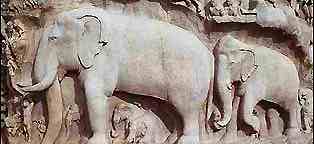 Every
linguist in the first half of the 19th century believed that Indic grammar
preserved practically everything from Indo-European. Indic phonetics and
Indic morphology were considered as the most archaic. For example, both
Bopp and Schleicher were sure Indo-European had had three vowels: *a,
*i, *u. This was proven completely incorrect already when in 1876
Karl Brugmann discovered and proved that the Celtic, Italic and Greek distinction
between a, e, o existed in Proto-Indo-European. That meant
that Indo-Iranian languages went too far in their phonology from the original
state - all three vowels coincided there. This fusion of the vocals surely
broke the whole vocalic system making it to some extent useless for the
comparative research. So it appeared that in phonetics, Greek, Latin or
Slavic are even more conservative, more archaic and closer to the Proto-Indo-European
stage. However, the interest towards Indo-Aryan languages remained high,
and nowadays Sanskrit and Vedic are still regarded as one of the ancient
Indo-European branches.
Every
linguist in the first half of the 19th century believed that Indic grammar
preserved practically everything from Indo-European. Indic phonetics and
Indic morphology were considered as the most archaic. For example, both
Bopp and Schleicher were sure Indo-European had had three vowels: *a,
*i, *u. This was proven completely incorrect already when in 1876
Karl Brugmann discovered and proved that the Celtic, Italic and Greek distinction
between a, e, o existed in Proto-Indo-European. That meant
that Indo-Iranian languages went too far in their phonology from the original
state - all three vowels coincided there. This fusion of the vocals surely
broke the whole vocalic system making it to some extent useless for the
comparative research. So it appeared that in phonetics, Greek, Latin or
Slavic are even more conservative, more archaic and closer to the Proto-Indo-European
stage. However, the interest towards Indo-Aryan languages remained high,
and nowadays Sanskrit and Vedic are still regarded as one of the ancient
Indo-European branches.
The same kind of story can be told about the question of the Indo-European
homeland, which was first suspected to have been situated in India but
later was moved to the west - modern scientists place it either in Near
East or in Eastern Europe. This means also that Indo-Aryans actually came
to India from the west - but where did they live before and what were their
ways towards their new motherland?
§ 1.
Historical, Epic and Archaeological Sources.
Modern archaeology allows us to suppose that in ancient times settlers
usually came to India from the north, via Iran and Afghanistan. That was
the way the first civilization appeared here, in the Indus Valley, nowadays
known as Harappan or the Mohenjo-Daro culture. It existed for five or six
centuries, created powerful city-states and wonderful monuments, and then
died out completely due to reasons still unknown.
Indo-European nomadic tribes which took its place in India were Aryans. Their closest relatives Iranians settled in Persia and Media in the beginning of the 1st millennium BC, while Aryan arrival can date back to the 14th century BC. Actually the term "Aryan" should be referred to both Indo-Iranian branches - they both called themselves ar, ir 'nobles' which was the name of their ancient community.
Indic epic, first of all Veda and classical poems, usually notices that Aryans came from the north. In legends described in Rigveda, the homeland of Aryans is placed somewhere in the north, where the climate is milder and colder than in India. The gap in time between Aryan arrival in India and Iranian settling down in Persia gives us another mystery - it seems that India was occupied by Indo-Europeans even earlier than Iran! This allowed some scientists to state that Indic settlers went from Eastern Europe via the Central Asian steppes, not touching the Caucasus mountains. Some correspondence can be found again in Rigveda, where the "region of the Seven Rivers" is mentioned several times - a widespread name for the Aral steppe district. However, not much of probable Indo-Aryan substratum glosses in toponymics and hidronymics of Central Asia can be found yet.
The most reliable archaeological evidence of early Indo-Aryan presence in India is the "gray decorated ceramics" culture. It was discovered in Eastern Punjab, Haryan, along the Upper Gang and Jamna. The zone of its spreading goes practically for sure from the west - that means from the territory of modern Pakistan. Still, the earlier ways are arguable, and no clear proofs exist that proto-Indic tribes migrated through Central Asian steppes, Iran or Caucasus. This gives way to several versions - archaeologically it is hard to identify the exact predecessors of the "gray decorated" culture. Some find it in the southern Ural with the famous Andronovo culture of the 3rd millennium BC (another possible Indo-European homeland?), or somewhere between the Caspian and the Aral Sea or more to the west in Eastern Europe.
So, neither archaeology, nor folk poems can make one sure about the
homeland and ways of Aryans to India. Let us then go through the linguistic
sources which can be even more reliable.
§ 2. Linguistic
Sources.
Sometimes linguistic analysis can give us even more than historical or archeological evidence. Especially concerning the pre-historic period, when no inscriptions were written and no cities were built by this or that nation. In that case we can gather the linguistic data and reconstruct not only the language itself, but the place of living, the way of life, religion and psychology of people who lived several thousand years ago. Names of rivers and streams, mountains and hills, ancient personal names later recorded by classical authors - that is all invaluable for linguists, because such data can reflect quite archaic stages of the language and can tell even the nationality of those whose trace in history was lost long ago.
A. Mitanni Aryan
In classical philology, in the previous century, it considered indisputable that Indo-Iranians went east from the Indo-European homeland, and then Iranians stay where they are situated now, and Indians went further to the Indus and the Gang Valleys. The birth of the Indo-Aryan ethnic group, so, was believed to take place somewhere in Iran or Afghanistan. This was hard to deny, as no other traces of Indic people were found at the time anywhere else but in India. However, new archaeological data from the Middle East broke the whole system and was sensational: new inscriptions of the Mitanni Empire in northern Mesopotamia, written in cuneiform, were proven Indo-European (while Mitanni was populated and ruled mainly by Hurritic and Semitic tribes)! After careful studies of Mitanni texts and names linguists learned some additional Indo-European-like words in the Mitanni lexicon. Moreover, though these words were long believed Hittite, or at least some Anatolian, later research showed that they were in fact Indo-Aryan. Even not Indo-Iranian, but Indic, used much later than the Indo-Iranian branch broke up in two.
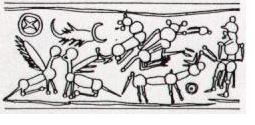
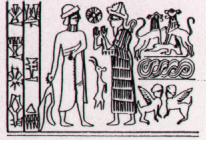 To
make serious conclusions, we should at first study the very material. Unfortunately,
the number of words and morphemes is quite small, but still they give us
a chance to identify the language. All of them date from the period between
1700 and 1400 BC, when the Mitanni
Empire was flourishing, just the moment when India was occupied by the
first waves of Indo-European nomads. So all versions of Aryan ways first
to Mitanni and then to India are not quite correct - at least some of migrants
must have stayed in Mesopotamia. After 1350 BC, when the Empire was destroyed,
all signs of the Indic language there disappears - it seems that the nation
was assimilated completely by Semitic and other people.
To
make serious conclusions, we should at first study the very material. Unfortunately,
the number of words and morphemes is quite small, but still they give us
a chance to identify the language. All of them date from the period between
1700 and 1400 BC, when the Mitanni
Empire was flourishing, just the moment when India was occupied by the
first waves of Indo-European nomads. So all versions of Aryan ways first
to Mitanni and then to India are not quite correct - at least some of migrants
must have stayed in Mesopotamia. After 1350 BC, when the Empire was destroyed,
all signs of the Indic language there disappears - it seems that the nation
was assimilated completely by Semitic and other people.
The words are known from several exact sources: Kikkuli's horse-breeding treatise written in Hittite but containing special professional terms from Indic (obviously, Aryans were known as good horse-breeders); the personal names of Mitanni princes and princesses; the names of deities on the Mitanni-Hatti treaties of the 14th century BC; a Hurrian text from Yorgan-Tepe; several Kassite documents with Akkadian translations. Here is the complete list:
Indara (Vedic & Avestan Indra)
Assura (Vedic Asura, Avestan Ahura)
Akni (Vedic Agni)
Miitra (Sanskrit & especially Avestan Mitra)
Vruwana-, Aruna- (Vedic & Avestan Varun.a)
Našattiia (Sanskrit Nasatya)
Suriiaaš (Vedic Surya) - names of deities;
Maruttaš (Vedic Marut)
aika - one (Sanskrit eka)
aššušanni - a stableman (Sanskrit ac,vasani)
na, nawa - nine (Sanskrit nava)
panza - five (Sanskrit panca)
šatta - seven (Sanskrit sapta)
tera, tiera, tri - three (Sanskrit tri)
wartanna - a turn, a turning (Sanskrit vartate
'he turns')
wašanna - a stadium;
babru - describing colours of horses (Sanskrit babhru
'brown')
parita - describing colours of horses (Sanskrit palita
'gray')
pinkara - describing colours of horses (Sanskrit pingala
'reddish')
marijannu - a charioteer, a young warrior (Vedic marya
'a young man, a soldier');
Tirgutawiya - a woman's name
Abirattaš - a king's name (Sanskrit abhi-ratha
'facing chariots')
Note:
1. The names of deities are for sure Indo-Iranian. Many of them coincide
also with Iranian, Avestan names, but we should note that in Mitanni Aryan
Indara and Vruwanassil are mentioned as powerful
gods, and in Avesta they are either minor deities (like Indra) or even
angry demons (like Varuna). Iranians and Aryans had something like antagonism
in religion, and so Iranians were fond of humiliating Indic gods. Mitanni
texts use the names for gods they want help from, so they just cannot be
Iranian. The last proof is the š in šatta and
wašanna, which would have become h in Iranian
(Avestan hapta 'seven').
2. The very abstract from the Mitanni-Hatti treaty reads
the following:
mi-it-ra-aš-si-il...
in-dar
na-ša-a (t-ti-ia-a)n-na...
mi-it-ra-aš-ši-il
a-ru-na-aš-ši-il
in-da-ra
na-ša-at-ti-ia-an-na (Winckler, Mitteilungen
der Deutschen Orient-Gesellschaft No. 35, 1907, p. 51, s. Boghazkoi-Studien
VIII, Leipzig 1923, pp. 32 f., 54 f.)
This text names all four treaty gods mentioned in Rigveda
(RV, 10.125.1).
We see that the majority of the terms above are parallel to those in Vedic and Sanskrit languages. The Anatolian origin of them is very doubtful then: Hittite tara- (three), nuwa (nine) and šipta- (seven) do not match so well, and moreover, aika (one) from Indo-European *oi-k- is a typical Indo-Iranian stem not found yet in other groups of the family.
A little of phonetic material can also tell us something. It seems that the language of Mitanni Aryans was not exactly like Vedic or Classical Sanskrit of India. Several dialectal features make it more likely another branch of the Indo-Aryan group:
šatta (seven) was sapta in India, so the group
-pt- must have assimilated to -tt- in Mitanni Aryan: this
feature later took place in Indic Prakrits,
while languages of classical literature, Vedic and Sanskrit, did not show
it at all. Probably that was a common, popular variant;
aika (one) instead of Indic eka or Kurdish (Iranian)
ek makes linguists think that Mitanni Aryan preserved diphthongs
which were lost in Vedic (but - note - were kept in Avestan). So the language
of Mitanni seems here more archaic.;
several variants of recording words which are considered Aryan allowed
to conclude that Mitanni Aryan was a satem language, and the Indo-European
palatal *g' became s here.;
parita and pinkara give us still another
feature - the preserved r between vowels, while in other
Indo-Iranian language it was transferred into l (palita and
pingala);
as for Tirgutawiya, this interesting female personal
name will be examined below, as it has a peculiar parallel in another Indo-Aryan
relict dialect.
So we support the idea about the separate Indo-Aryan language called Mitanni Aryan and spoken by some ethnic minority of Mitanni in the 2nd millennium BC. How did Aryans reach Mesopotamia? We do not know whether it was a branch of the group which chose another way from Eastern Europe to the east than the general wave, or maybe this language is a relict of the whole Indo-Aryan group which migrated across these lands. Then where from did Aryans go, and what was their homeland?
The latest discoveries in linguistics of the Black Sea region say - Indic people were there.
B. Pontic Aryan
The first to suggest the hypothesis of Indo-Aryan presence in the region
north and east to the Black Sea was Paul Kretschmer; in his work Inder
am Kuban (Wien, 1944) he managed to gather several facts and historical
evidence to state that tribes mentioned by Herodot, namely Sindes and Maeotes,
were Indic by origin. Kretschmer noticed just a few etymologies which he
thought were Indo-Aryan, but he even did not pay attention to hundreds
of glosses and toponymic items which should be used together with analyzing
the historical data.
That Kretschmer's work (and a few ones afterwards) was just a drop in the sea of linguistic literature. The general point of view about the Pontic region as the one historically populated by Scythians and their Iranian relatives remained decisive in the discussion of the matter. Every little sign of an ancient language around the Black Sea, in Crimea and in the Northern Caucasian region was transcribed as Scythian - though attempts to identify everything in hydronymics and toponymics as Scythian was sometimes unsuccessful.
Another large discovery was a series of articles issued in Russian, American and German journals between 1975 and 1989 by Oleg Trubachov, who first managed to gather large range of data from Pontic districts and the Caucasus and to state that the language of people who used to live there were Indo-Aryan by origin. The book by Trubachov combining all his previous articles was called Indoarica in the North Black Sea region and was published in Moscow in 1999 ("Nauka"). This opened a new stream in the studies of Indo-Aryan languages and the history of the Indo-European family as a whole. The most part of material given below was taken from that very book
It seems now that Indo-Aryans used to inhabit lands along the Black Sea shores even in Herodot's times: the tribes he mentions in his "Historia", Sindes and Maeotes, are separated out from Scythians as a different nation: they were involved in agriculture and cattle-breeding, and occupied the fertile region on both sides of the Don river (then called Tanais), lived also along the Kuban river and at the foot of the Caucasus. Traditionally linguists and historians called Sindo-Meotians "an unclear nation", while some of them supposed their Iranian origin. However, it appears impossible to explain everything from Scythian, and one of the scholars stated that "all we cannot explain with the help of Iranian, actually cannot be explained at all" (Abaev V. The Ossetic Language and Folklore. P. 37). This cannot be correct, and moreover: a lot of facts which used to be explained from Iranian should be reconsidered now.
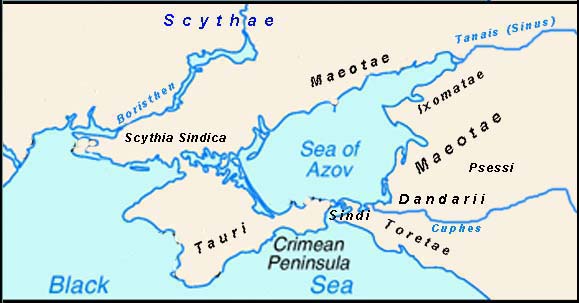 It
looks as if ancient authors knew two named for Sindes: in Greek Sindoi
and Indoi; the second variant is for sure Iranian - their language
lost s- in initial position and between vowels, turning it into
h-. Herodot uses in most cases the form Indoi, which he must
have heard from Scythians in Greek polises on the Black Sea shores, while
many other sources (like Strabo, Dionysius, Stephen Byzantine, Polienus
etc.) use Sindoi or Sindi, Sindones, the form they could
probably hear on the spot. Another interesting gloss is the Hesychius's
dictionary which gives the following: Sindoi ethnos Indikon. There
were many versions of interpreting this: "Sindes - a Sindic tribe",
which is a nonsense, or "Sindes - a Scythian tribe" which is too
far from the text and therefore doubtful. The most natural will be the
translation "Sindes - an Indic tribe" which can be true.
It
looks as if ancient authors knew two named for Sindes: in Greek Sindoi
and Indoi; the second variant is for sure Iranian - their language
lost s- in initial position and between vowels, turning it into
h-. Herodot uses in most cases the form Indoi, which he must
have heard from Scythians in Greek polises on the Black Sea shores, while
many other sources (like Strabo, Dionysius, Stephen Byzantine, Polienus
etc.) use Sindoi or Sindi, Sindones, the form they could
probably hear on the spot. Another interesting gloss is the Hesychius's
dictionary which gives the following: Sindoi ethnos Indikon. There
were many versions of interpreting this: "Sindes - a Sindic tribe",
which is a nonsense, or "Sindes - a Scythian tribe" which is too
far from the text and therefore doubtful. The most natural will be the
translation "Sindes - an Indic tribe" which can be true.
Moreover, if we look at the very name Sindoi we should note that it for sure was not Iranian - in all Iranian dialects the initial s- became h-; the parallel can be placed here: The Indo-Aryan settlers in India called the river Indus sindhu-, later it acquired the meaning 'any river'. Iranians borrowed this term and called the country of Aryans hindu-; that's where the very name India comes from. So the varying name of the tribe around the Black Sea Sindoi - Indoi, Sindikes - Indikes should not be a stumbling point for linguists - that is just an evidence of Iranian contacts with a nation called that way.
Nothing is known from the language of Sindes from works of ancient authors; but that is probably not the fault of Sindes - actually, many place names, river names and other terms were recorded by historians and geographers as Scythian ones, though in fact they are Sindic by origin and just cannot be Scythian. Many linguists tried to explain such words and their etymology from Iranian but often failed. One of good examples is the gloss given by Plinius: "Tanaim ipsum Scythae Sinum vocant, Maeotim Temarundam, quo significant matrem maris" (The very Tanais is called Sinu- by Scythians, and Maeotida [i.e. the Azov Sea] is called Temarunda, which means 'mother of the sea'). This gives us two words which were for sure Sindo-Maeotic: temarunda and sinu-. The latter of them can mean just 'a river' following the Indic sindhu-, and as for the first, it can be analyzed as *tem-arun-da 'mother of the Dark, or Black, Sea', where *tem- means Vedic tamas 'darkness', *arun- is Vedic arna- 'a stormy sea', and *-da fits well to Sanskrit dhe- 'to breast-feed'. This makes temarunda really 'a mother of the sea'.
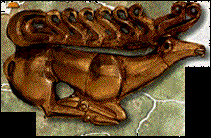 One
of such mistakes of ancient authors who take Sindo-Maeotic words for Scythian
ones, is the Hesychius's mesple which he translates as 'the
moon in Scythian'. This looks much more Indic than Scythian, with its mes-
'moon' (Indic mas, Iranian mah) and ple-/pla-
'full' (Indic -pra), i.e. mesple means 'full moon'.
One
of such mistakes of ancient authors who take Sindo-Maeotic words for Scythian
ones, is the Hesychius's mesple which he translates as 'the
moon in Scythian'. This looks much more Indic than Scythian, with its mes-
'moon' (Indic mas, Iranian mah) and ple-/pla-
'full' (Indic -pra), i.e. mesple means 'full moon'.
A lot of personal names, river names and ancient towns on the shores of the Black Sea now can be interpreted as the words of the unknown Indo-Aryan dialect. Some of them really amaze us with their equivalents in India. The river where Sindes and Maeotes lived in Herodot's times, was called Cuphis, Kophina, Kouphes then (now the Kuban river). This can be identified with the name of the river Kabul which flows into the Indus from the west: it was called Kophes by Strabo (XV, 697), and Kubha by ancient Indians. Ancient history knows quite a lot of similar examples, when river names were transferred to new lands where migrants settle.
Another interesting example gives us a link to Indo-Aryans in Mitanni described above: one of Maeotic princesses, a wife of a Sindic king, from the tribe of Ixomates, was called Tirgatao by a Greek author, while practically the same name, Tirgutawiya, was found in one of Mitanni tablets in Alalakh, Mesopotamia.
Archaeological research of the Pontic region around the Don river and some more historical evidence allow us to state that Sindes were involved in agriculture and that's why were not nomadic, as Scythians. Remains of ancient channels they built to irrigate their fields can still be seen there, and these irrigations were meant already by Roman travelers. This fact is just another proof of deep differences between Sindo-Maeotes and Scythian nomads.
In his book, Trubachov gives about a hundred of etymological units of the Indo-Aryan Pontic language. Many of them were found also in the Crimea peninsula, where ancient works place the nation of Taures, again different from Scythians. The very name for the river Dniepr, adopted in ancient times, Boristhen, can be regarded as an Indo-Aryan word. After composing a sort of an etymological dictionary of the Indo-Aryan language at the Black Sea, Trubachov tries to show the dialectal features in its phonetics, to make a distinction between Vedic and Pontic Indo-Aryan.
The Pontic language seems to have been much more archaic. It preserves the phoneme -l- which became -r- everywhere in Vedic (Pontic *alaksa 'forbidden' vs. Vedic raksati 'to guard'); it turns the group -pt- into -tt- (NOTE: the same as in Mitanni Aryan; *satt-auka 'seven dwellings' vs. Vedic sapta 'seven'); it opposes -c'- [ch] to Vedic -ks'- [ksh] (*kac'ika- 'coast' vs. Vedic kaks'a-, Prakrit kaccha-). Many dialectal words can be noticed which are Indo-European but were forgotten in Vedic:
*saul- 'the sun' (in Saulios 'a king's name')
from IE *sawel- vs. Vedic surya-;
*artaka- 'a bear' (in Artakia 'Bear-mountain')
from IE *Harkt- vs. Vedic rksa-;
*biti- 'to beat, to kill' (in Bitiae 'women
who kill with eyes') from IE *bhei-; etc.
That all makes Pontic Aryan another dialect of the Indo-Aryan branch.
Their language was already separated from Iranian when they left their
traces in Northern Mesopotamia and on the shores of the Black Sea.
§ 3. Conclusion.
Linguistic, historical, epic and archaeological sources define three points on the map of Eurasia where Indo-Aryans used to live. They are, first of all, India itself [3], where Aryans appeared about 1700 BC from the north or from the west. Shortly afterwards the first Indic written epic, Rigveda, was written, and it still remains one of the most archaic Indo-European literature creations.
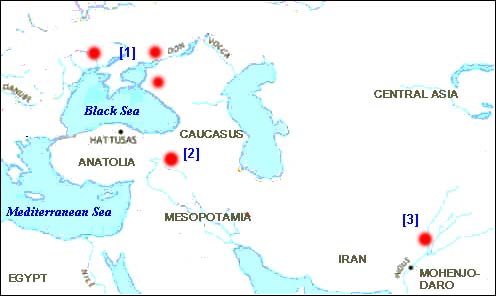 Second
is Northern Mesopotamia [2], where Mitanni cuneiform documents witness
Indo-Aryan presence somewhere between 1700 and 1400 BC. The language of
Aryans in Mitanni was a dialectal form of Vedic and sometimes seems even
more progressive, though keeps some archaic traits. Aryans in the Mitanni
Empire did not make a majority and were not the title nation; still, they
were influential enough to introduce their religious system which was used
in Mitanni together with Hurritic. So we can speak here about some kind
of offspring of Aryans who came here at the same time as their relatives
Vedic Aryans reached the Indus Valley.
Second
is Northern Mesopotamia [2], where Mitanni cuneiform documents witness
Indo-Aryan presence somewhere between 1700 and 1400 BC. The language of
Aryans in Mitanni was a dialectal form of Vedic and sometimes seems even
more progressive, though keeps some archaic traits. Aryans in the Mitanni
Empire did not make a majority and were not the title nation; still, they
were influential enough to introduce their religious system which was used
in Mitanni together with Hurritic. So we can speak here about some kind
of offspring of Aryans who came here at the same time as their relatives
Vedic Aryans reached the Indus Valley.
And the third Indic "homeland" is the Pontic region [1]. Some facts and suggestions stress that these lands were really a starting point for Aryan migrations to the East. Toponymic and hydronymic data becomes more and more evident from the Dniepr to the Don river - Indo-Aryans probably moved rather slowly. We cannot say when was the moment of mass emigration of Indic tribes from here, but that for sure took place after the Indo-Iranian unity had broken. Supposedly, it was here, at the Black Sea, where it broke up. When the Indo-Aryan wave went further to the east, a short branch of them stayed here and were called Sindes and Maeotes by Greeks: they lived here, being neighbours of Scythians, up to the beginning of the new era, when they were gradually assimilated.
So the probable way of Indo-Aryan expansion could took place from Pontic steppes - via the Caucasus - to the Middle East - and then via Iran and Punjab to India. Else, they could reach India going crossing Central Asia, but in that case the Mitanni subgroup chose just another way from the Black Sea - to Mesopotamia.
But whatever their ways were, now we can only guess about it. New materials will for sure be added by historians, archaeologists and linguists, and what we should do is just to research.